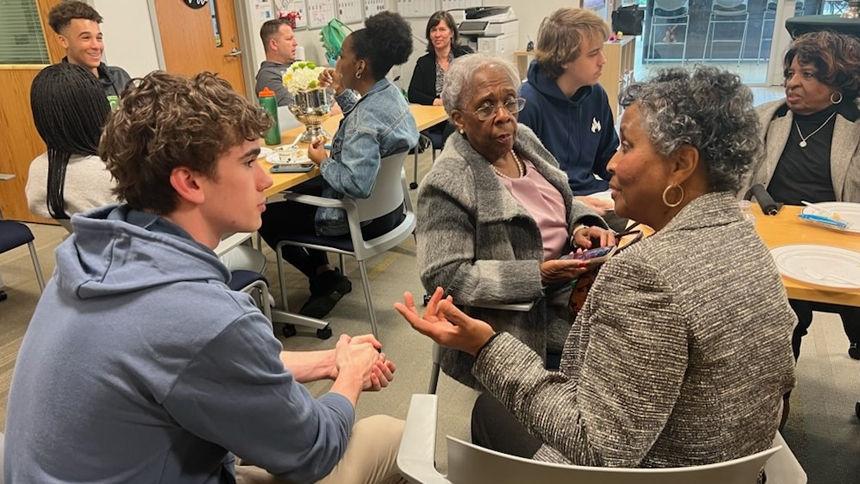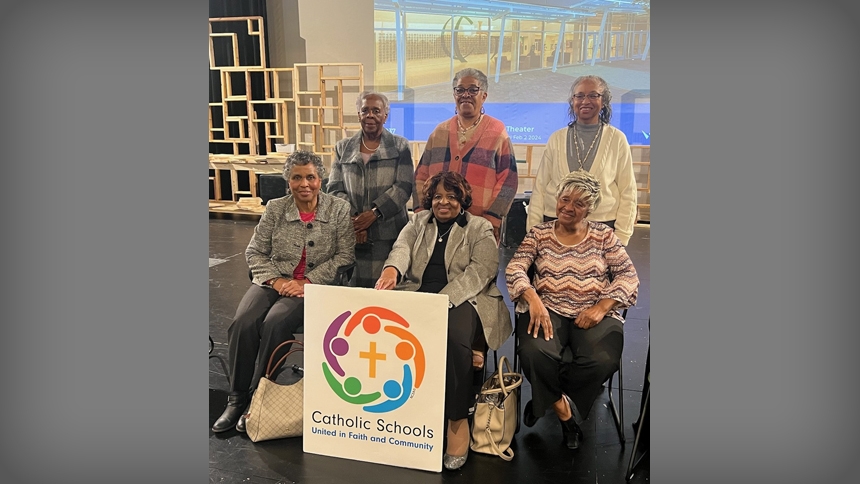
Above (foreground): St. Monica Catholic School graduate Joyce (Sanders) Bass (right) converses with Cardinal Gibbons High School senior Sutton Stump (left) following the Feb. 2 St. Monica House meeting.
RALEIGH — Hazel Sanders looked at those gathered in the Cardinal Gibbons High School theater Feb. 2. She saw the attentive faces of more than 200 students, who represented the diversity of the Diocese of Raleigh. Sanders began the discussion. As a 1962 graduate of St. Monica Catholic School, which educated Black students in Raleigh from 1930 until 1967, she offered a reminder.
“All of us were born into a segregated society,” she said of the six panelists. “This [event today] would not have been possible [during the 1950s and 1960s].”
St. Monica School, she shared, was housed in a four-classroom brick building at the intersection of Raleigh’s Tarboro Road and New Bern Avenue. A cross was featured over the doors of the building, which stills stands today.
Panelists discussed the school’s legacy of Gospel-witnessing service and academic excellence.
This service included fostering public school integration. In 1960, Bill Campbell, who was elected Mayor of Atlanta in 1993, left St. Monica as a student to integrate Raleigh’s Murphey Elementary School.
St. Monica was among Raleigh’s earliest schools to teach reading using the phonetic method. Students were offered on-campus music classes, which laid a foundation for subsequent Church liturgical ministries.
Sanders was joined on the panel by fellow St. Monica graduates, including her sister, Joyce (Sanders) Bass, Maritza Hicks, Jacque Peebles, Adelaide (Cobb) Reddick and Vernice (Holt) Whyms.
Paul Jervay, a graduate whose family owns and publishes The Carolinian newspaper, sent prepared remarks, which Sanders read for the assembly.
“St. Monica graduates, sharing firsthand accounts of their Catholic education and formation in a segregated school, is a foundational element of Cardinal Gibbons' integration legacy,” said Susan Leigh, director of Alumni Advancement at the school.
St. Monica was Gibbons’ integration lifeline when the latter school (known previously as Cathedral Latin) became North Carolina’s first integrated high school on August 31, 1954. Sanders and Peebles are Cardinal Gibbons graduates, too.
Gibbons was celebrating Black History Month and Catholic Schools Week when it hosted the panel Feb. 2. The high school, which has more than 1,500 students, uses a four-house system to build smaller community relationships. Each house’s name offers tribute to part of the school’s history. St. Monica House is one of the four.
Bass and Sanders both have served on the high school’s governing board at different times.
“The impact of St. Monica on the ongoing evolution of Cardinal Gibbons High School continues through St. Monica students and their offspring who have attended and worked at Cardinal Gibbons and give service to Cardinal Gibbons in various ways,” said Bass.
Following the meeting, Leigh and students led the St. Monica graduates to Cardinal Gibbons’ hallway dedicated to St. Monica. One wall includes a “St. Monica’s” marquee in blue and white – the school’s colors honoring the Blessed Mother.
“We’re with the history – in real life,” Cardinal Gibbons sophomore Jakub Mudd said. “It’s important to share this history so it doesn’t get lost in history.”
Sutton Stump, a senior at the school, echoed Mudd’s sentiments. Stump noted how people often remember other southern cities like Birmingham, Alabama, while overlooking Raleigh and the perseverance of local pioneers amidst segregation.
“It was happening right here in Raleigh,” Stump said. “That was a really important time in our history.”
The recorded panel discussion and subsequent one-on-one conversations among the St. Monica graduates and Cardinal Gibbons students are the start of a process for deepening students’ knowledge of the St. Monica-Cardinal Gibbons relationship.
Stump asked Sanders for a copy of Jervay’s remarks to contribute to future gatherings. Compiling oral history will offer Cardinal Gibbons students a perspective that studying print and digital resources cannot offer.
“These are real people who have gone through things,” junior Claudia Nkidiaka said. “We can learn from them.”
Below: St. Monica Catholic School graduates participated in a panel discussion Feb. 2 at Cardinal Gibbons High School in Raleigh. Participants were (front row, left to right): Joyce (Sanders) Bass, Vernice (Holt) Whyms, Adelaide (Cobb) Reddick and (back row left to right): Hazel Sanders, Jacque Peebles, Maritza Hicks.


